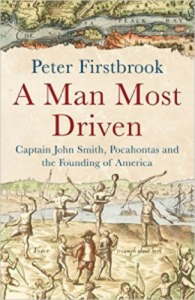
BBC Documentary Producer Travels with Captain Smith
Did you know that Captain John Smith was not romantically involved with Pocahontas (she was a mere child), that he was not the liar and boaster some call him, that he named New England, that he fought the Turks, saved Jamestown, escaped from pirates, survived an almost deadly gunpowder explosion, and was an amazingly resourceful, clever, and entertaining hero who deserves his own television action series? The last is my own suggestion, but you can find the rest and a lot more in this innovatively researched account by Peter Firstbrook who traveled far and wide to test the writings of John Smith.
According to Goodreads, Peter Firstbrook worked for the British Broadcasting Corporation (BBC) for 25 years as a director and producer of historical documentaries. He is also the author of The Voyage of the Matthew about explorer John Cabot.
A Man Most Driven, Captain John Smith, Pocahontas and the Founding of America is a 2014 project by Firstbrook and is a great and valuable read for anyone. As an author, researcher, historian, and general fan of good stories, I absolutely love this book. And I greatly appreciate all the hard, thoughtful, thorough, and fascinating work done by Firstbrook, even though I had to wince through a few gruesome (but very real) events. Oh, should we value the sacrifices of those early settlers of America!
As a documentary type of fellow, Firstbrook did his own out-of-the-way traveling to see just how many and much of the stories recorded by the legendary and almost mythical John Smith the experienced producer could verify. You may well be surprised. I now have a much, much clearer view of the deservedly famous Captain Smith, as well as a broader understanding of Europe, England, and America in the late 16th and early 17th Centuries. This is no dry history. This is an amazing and entertaining story, told well, and well documented.
Though my own research leads me to believe the author fell down a minor notch on the Squanto kidnapping scenario (which is due mainly to Sir Ferdinando Gorges’ slightly faulty memory many years after the fact), I would require this book as reading in every high school.
I had never read anything but a little standard fare on the good Captain, but the more I learned from Firstbrook, it seemed that both he and I cannot help but admire ~ and marvel at ~ a son of a tenant farmer who devised his own rigorous physical and intellectual self-training program, became a captain of cavalry by fighting to save Europe from the Turks, who managed to continually either dodge or survive close calls with death, escaped from a cruel Turkish slave master, repeatedly saved the colony of Jamestown from extinction, and extricated himself from a number of “you’ve got to be kidding” episodes with pirates. There are those who have thought Smith’s memoir to be tales too fantastical, but Firstbrook gives it all a serious exam. It’s educational and downright entertaining.
A Documented Tale for the Telling
Here is one of my favorite accounts, from a trip of exploration Smith led while in Jamestown, far up the Chesapeake Bay. One of the men was Nathanael Powell, who later left an eye-witness report. As Firstbrook writes, the men encountered members of the “fearsome Massawomeck tribe.”
Smith had to think quickly. With only six men healthy enough to fight, he and his crew were vastly outnumbered. His solution was as inventive as the multitude of glowing tapers he used to deceive the Turks. First, he hid his eight sick men under a tarpaulin and took away their hats. The hats he placed on sticks that he wedged along the side of the shallop, to create the appearance of a larger crew. He then ordered the shallop to pursue the canoes, rather than retreat from them.
“Think quickly” was a skill Smith required often in life. Note that he pursued rather than retreated. But the best part comes next. Smith followed the warriors into the shallows, then beckoned amiably for them to come over. It was the type of unexpected action that would have made Machiavelli proud.
He gave them each a bell and trading commenced. He ended up with a heap of meat and woven shields that would save their bacon later. However, the Massawomeck shields also caused another problem the next day. The Tockwogh, “sworn enemies of the Massawomeck,” saw the shields of their foes and challenged Smith. Once again thinking “on his feet” and “on his seat” (in the canoe!), he informed the Tockwogh that the shields were “spoils of war.” They were impressed by these obviously very brave strangers! This fortuitous encounter led, in turn, to what amounted to a valuable intelligence briefing by the Iroquoian Susquehannock, who possessed weapons of iron and brass from the French, as well as extensive knowledge of many other tribes and their languages, all of which would go into Smith’s detailed notes and report.
The resourceful captain knew how to call up cunning bravado that worked in his favor and often saved lives. In years to come, he would demonstrate his intelligence as well as observational and mapping skills in his valuable reports of Virginia and New England. He truly saved Jamestown, and his exploration and advertising of New England helped give us an English America. He correctly saw the New World as an open door to liberty and opportunity, even for the son of a tenant farmer.
Firstbrook states that Smith “always aspired to be a chivalric knight.” Look for more on Smith in the Nerd’s blog and in Braving the New World. We indeed owe Captain John Smith our attention, appreciation, and admiration, and we owe Firstbrook genuine thanks for applying his documentary skills and experience to testing the truthfulness of the Captain’s extensive writings. If you are interested in the good Captain, this is the first book I would pick up.

